BZ332 Assignment 1: SHRM, Personnel Management, and Employees
VerifiedAdded on 2023/06/07
|5
|1207
|246
Report
AI Summary
This report examines Strategic Human Resource Management (SHRM) in contrast to personnel management models and their effectiveness in achieving organizational goals. The report begins with an introduction to SHRM, highlighting its importance in aligning human resources with strategic goals. It then compares and contrasts SHRM with personnel management, detailing their similarities and differences, such as SHRM's focus on organizational benefits versus personnel management's focus on employee and administrative aspects. A key section explores the relationship between work and individuals through a Biblical perspective, emphasizing the importance of hard work and dedication. The report concludes by discussing the crucial role of employees in achieving organizational goals, emphasizing how their efforts contribute to the success of the company. The report is based on BZ332 Human Resource Management course.
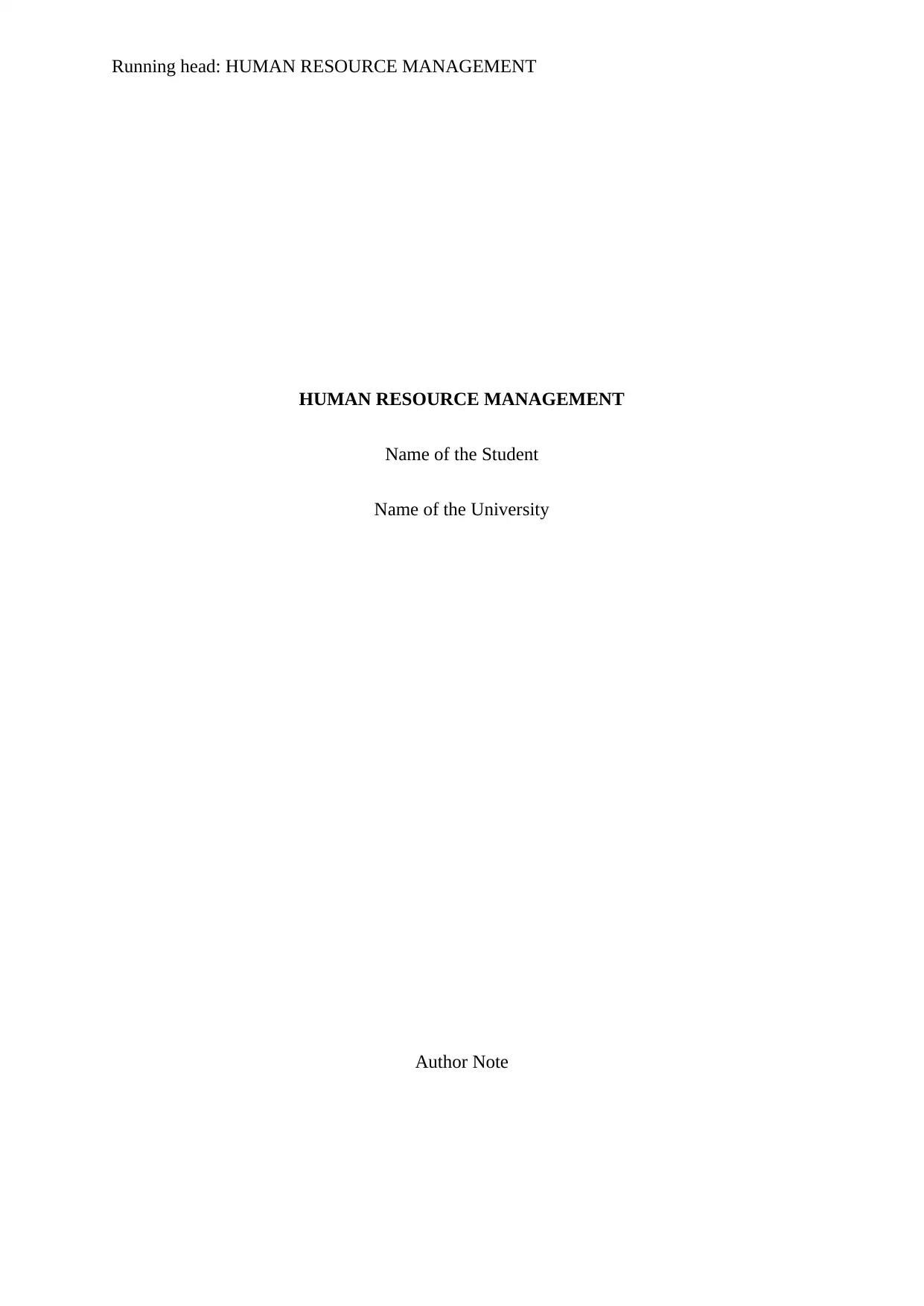
Running head: HUMAN RESOURCE MANAGEMENT
HUMAN RESOURCE MANAGEMENT
Name of the Student
Name of the University
Author Note
HUMAN RESOURCE MANAGEMENT
Name of the Student
Name of the University
Author Note
Paraphrase This Document
Need a fresh take? Get an instant paraphrase of this document with our AI Paraphraser
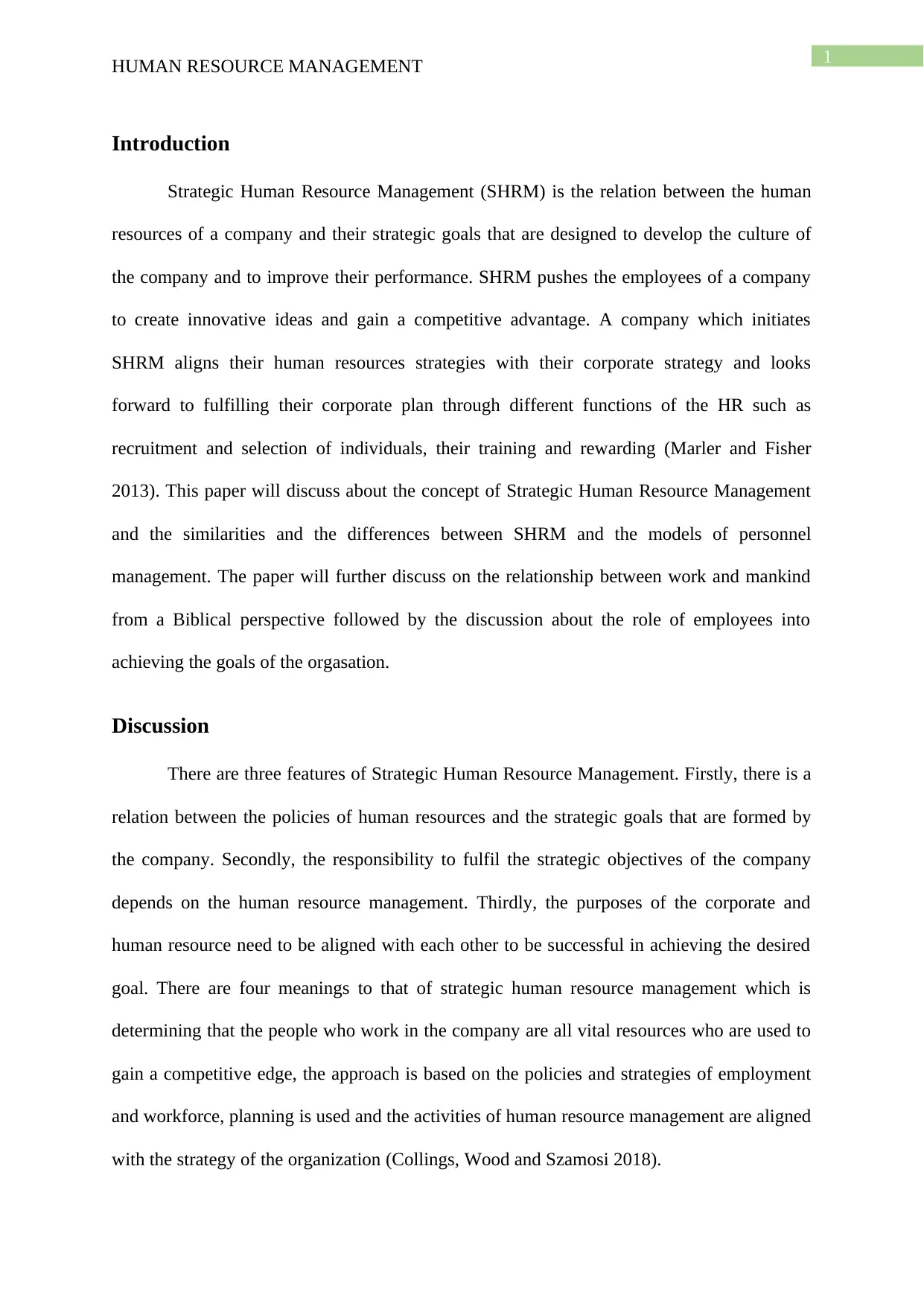
1
HUMAN RESOURCE MANAGEMENT
Introduction
Strategic Human Resource Management (SHRM) is the relation between the human
resources of a company and their strategic goals that are designed to develop the culture of
the company and to improve their performance. SHRM pushes the employees of a company
to create innovative ideas and gain a competitive advantage. A company which initiates
SHRM aligns their human resources strategies with their corporate strategy and looks
forward to fulfilling their corporate plan through different functions of the HR such as
recruitment and selection of individuals, their training and rewarding (Marler and Fisher
2013). This paper will discuss about the concept of Strategic Human Resource Management
and the similarities and the differences between SHRM and the models of personnel
management. The paper will further discuss on the relationship between work and mankind
from a Biblical perspective followed by the discussion about the role of employees into
achieving the goals of the orgasation.
Discussion
There are three features of Strategic Human Resource Management. Firstly, there is a
relation between the policies of human resources and the strategic goals that are formed by
the company. Secondly, the responsibility to fulfil the strategic objectives of the company
depends on the human resource management. Thirdly, the purposes of the corporate and
human resource need to be aligned with each other to be successful in achieving the desired
goal. There are four meanings to that of strategic human resource management which is
determining that the people who work in the company are all vital resources who are used to
gain a competitive edge, the approach is based on the policies and strategies of employment
and workforce, planning is used and the activities of human resource management are aligned
with the strategy of the organization (Collings, Wood and Szamosi 2018).
HUMAN RESOURCE MANAGEMENT
Introduction
Strategic Human Resource Management (SHRM) is the relation between the human
resources of a company and their strategic goals that are designed to develop the culture of
the company and to improve their performance. SHRM pushes the employees of a company
to create innovative ideas and gain a competitive advantage. A company which initiates
SHRM aligns their human resources strategies with their corporate strategy and looks
forward to fulfilling their corporate plan through different functions of the HR such as
recruitment and selection of individuals, their training and rewarding (Marler and Fisher
2013). This paper will discuss about the concept of Strategic Human Resource Management
and the similarities and the differences between SHRM and the models of personnel
management. The paper will further discuss on the relationship between work and mankind
from a Biblical perspective followed by the discussion about the role of employees into
achieving the goals of the orgasation.
Discussion
There are three features of Strategic Human Resource Management. Firstly, there is a
relation between the policies of human resources and the strategic goals that are formed by
the company. Secondly, the responsibility to fulfil the strategic objectives of the company
depends on the human resource management. Thirdly, the purposes of the corporate and
human resource need to be aligned with each other to be successful in achieving the desired
goal. There are four meanings to that of strategic human resource management which is
determining that the people who work in the company are all vital resources who are used to
gain a competitive edge, the approach is based on the policies and strategies of employment
and workforce, planning is used and the activities of human resource management are aligned
with the strategy of the organization (Collings, Wood and Szamosi 2018).
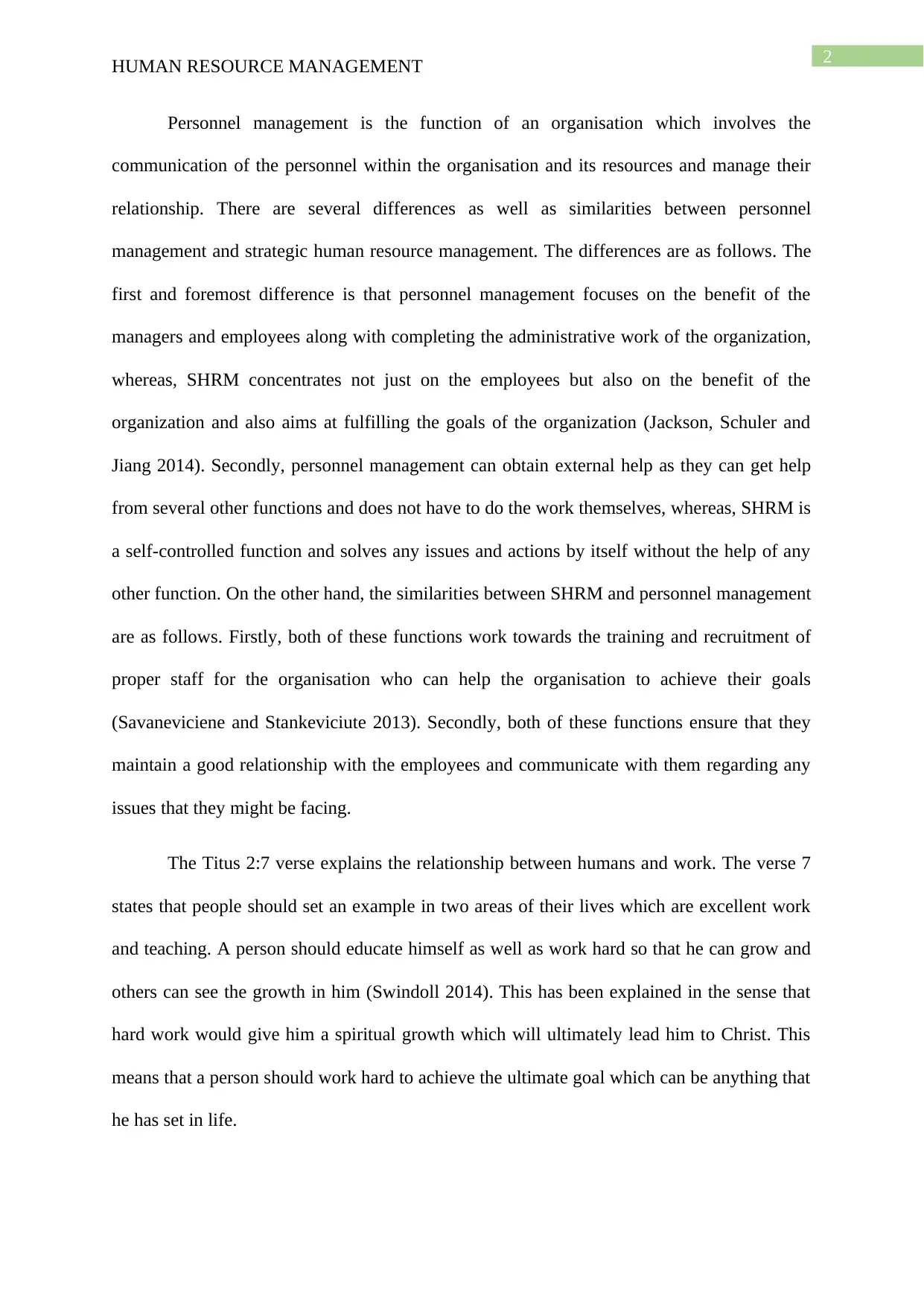
2
HUMAN RESOURCE MANAGEMENT
Personnel management is the function of an organisation which involves the
communication of the personnel within the organisation and its resources and manage their
relationship. There are several differences as well as similarities between personnel
management and strategic human resource management. The differences are as follows. The
first and foremost difference is that personnel management focuses on the benefit of the
managers and employees along with completing the administrative work of the organization,
whereas, SHRM concentrates not just on the employees but also on the benefit of the
organization and also aims at fulfilling the goals of the organization (Jackson, Schuler and
Jiang 2014). Secondly, personnel management can obtain external help as they can get help
from several other functions and does not have to do the work themselves, whereas, SHRM is
a self-controlled function and solves any issues and actions by itself without the help of any
other function. On the other hand, the similarities between SHRM and personnel management
are as follows. Firstly, both of these functions work towards the training and recruitment of
proper staff for the organisation who can help the organisation to achieve their goals
(Savaneviciene and Stankeviciute 2013). Secondly, both of these functions ensure that they
maintain a good relationship with the employees and communicate with them regarding any
issues that they might be facing.
The Titus 2:7 verse explains the relationship between humans and work. The verse 7
states that people should set an example in two areas of their lives which are excellent work
and teaching. A person should educate himself as well as work hard so that he can grow and
others can see the growth in him (Swindoll 2014). This has been explained in the sense that
hard work would give him a spiritual growth which will ultimately lead him to Christ. This
means that a person should work hard to achieve the ultimate goal which can be anything that
he has set in life.
HUMAN RESOURCE MANAGEMENT
Personnel management is the function of an organisation which involves the
communication of the personnel within the organisation and its resources and manage their
relationship. There are several differences as well as similarities between personnel
management and strategic human resource management. The differences are as follows. The
first and foremost difference is that personnel management focuses on the benefit of the
managers and employees along with completing the administrative work of the organization,
whereas, SHRM concentrates not just on the employees but also on the benefit of the
organization and also aims at fulfilling the goals of the organization (Jackson, Schuler and
Jiang 2014). Secondly, personnel management can obtain external help as they can get help
from several other functions and does not have to do the work themselves, whereas, SHRM is
a self-controlled function and solves any issues and actions by itself without the help of any
other function. On the other hand, the similarities between SHRM and personnel management
are as follows. Firstly, both of these functions work towards the training and recruitment of
proper staff for the organisation who can help the organisation to achieve their goals
(Savaneviciene and Stankeviciute 2013). Secondly, both of these functions ensure that they
maintain a good relationship with the employees and communicate with them regarding any
issues that they might be facing.
The Titus 2:7 verse explains the relationship between humans and work. The verse 7
states that people should set an example in two areas of their lives which are excellent work
and teaching. A person should educate himself as well as work hard so that he can grow and
others can see the growth in him (Swindoll 2014). This has been explained in the sense that
hard work would give him a spiritual growth which will ultimately lead him to Christ. This
means that a person should work hard to achieve the ultimate goal which can be anything that
he has set in life.
⊘ This is a preview!⊘
Do you want full access?
Subscribe today to unlock all pages.

Trusted by 1+ million students worldwide
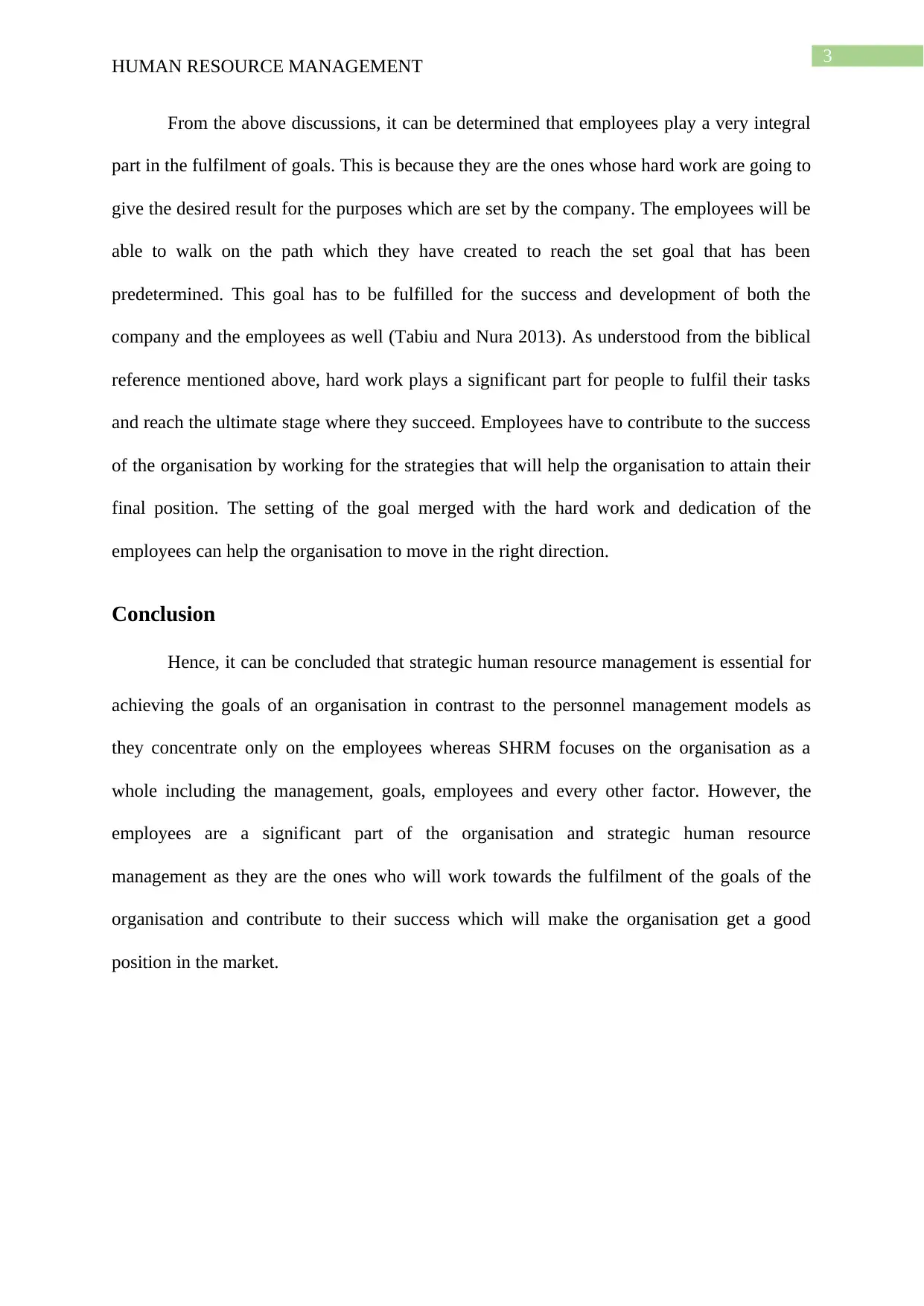
3
HUMAN RESOURCE MANAGEMENT
From the above discussions, it can be determined that employees play a very integral
part in the fulfilment of goals. This is because they are the ones whose hard work are going to
give the desired result for the purposes which are set by the company. The employees will be
able to walk on the path which they have created to reach the set goal that has been
predetermined. This goal has to be fulfilled for the success and development of both the
company and the employees as well (Tabiu and Nura 2013). As understood from the biblical
reference mentioned above, hard work plays a significant part for people to fulfil their tasks
and reach the ultimate stage where they succeed. Employees have to contribute to the success
of the organisation by working for the strategies that will help the organisation to attain their
final position. The setting of the goal merged with the hard work and dedication of the
employees can help the organisation to move in the right direction.
Conclusion
Hence, it can be concluded that strategic human resource management is essential for
achieving the goals of an organisation in contrast to the personnel management models as
they concentrate only on the employees whereas SHRM focuses on the organisation as a
whole including the management, goals, employees and every other factor. However, the
employees are a significant part of the organisation and strategic human resource
management as they are the ones who will work towards the fulfilment of the goals of the
organisation and contribute to their success which will make the organisation get a good
position in the market.
HUMAN RESOURCE MANAGEMENT
From the above discussions, it can be determined that employees play a very integral
part in the fulfilment of goals. This is because they are the ones whose hard work are going to
give the desired result for the purposes which are set by the company. The employees will be
able to walk on the path which they have created to reach the set goal that has been
predetermined. This goal has to be fulfilled for the success and development of both the
company and the employees as well (Tabiu and Nura 2013). As understood from the biblical
reference mentioned above, hard work plays a significant part for people to fulfil their tasks
and reach the ultimate stage where they succeed. Employees have to contribute to the success
of the organisation by working for the strategies that will help the organisation to attain their
final position. The setting of the goal merged with the hard work and dedication of the
employees can help the organisation to move in the right direction.
Conclusion
Hence, it can be concluded that strategic human resource management is essential for
achieving the goals of an organisation in contrast to the personnel management models as
they concentrate only on the employees whereas SHRM focuses on the organisation as a
whole including the management, goals, employees and every other factor. However, the
employees are a significant part of the organisation and strategic human resource
management as they are the ones who will work towards the fulfilment of the goals of the
organisation and contribute to their success which will make the organisation get a good
position in the market.
Paraphrase This Document
Need a fresh take? Get an instant paraphrase of this document with our AI Paraphraser
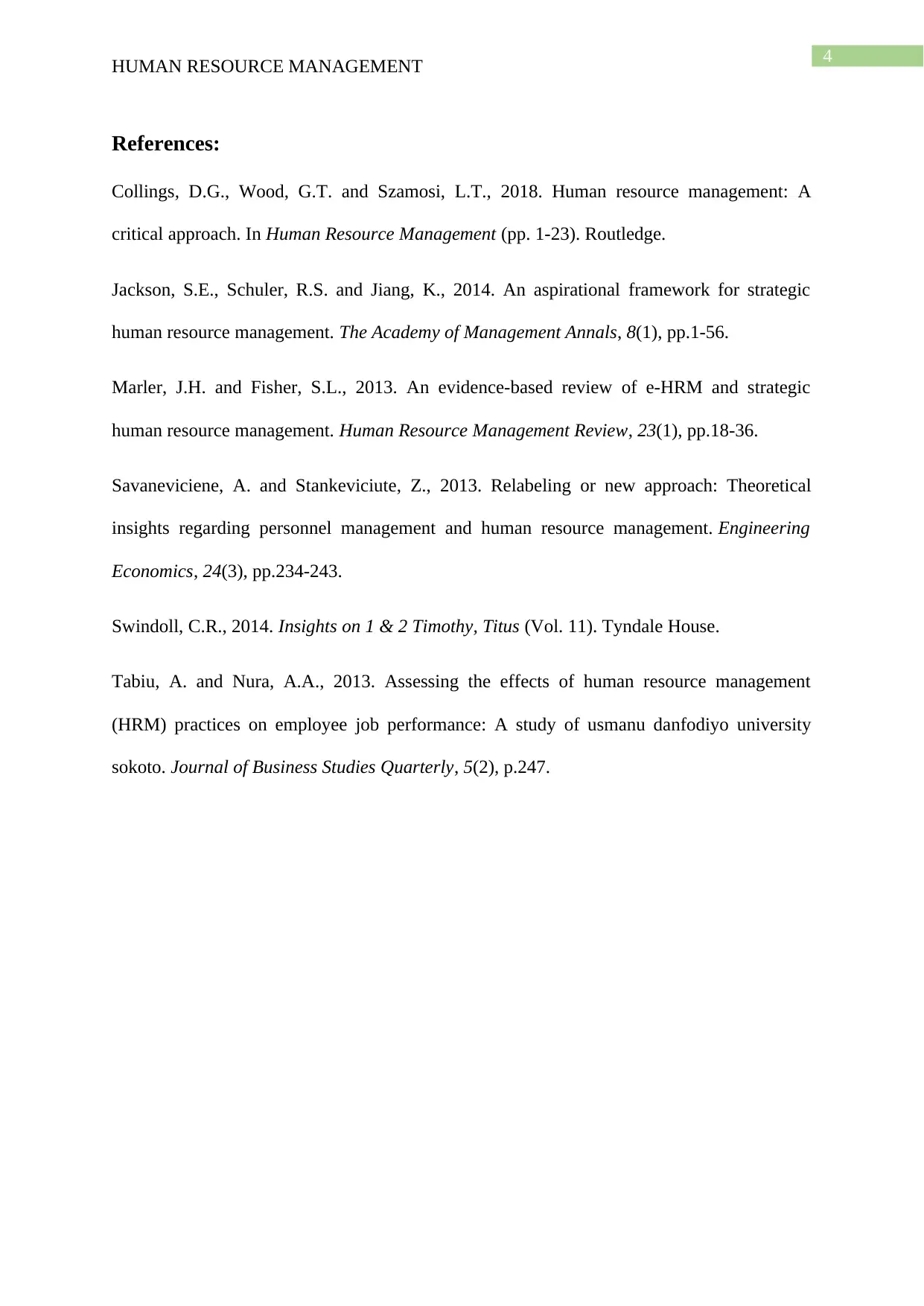
4
HUMAN RESOURCE MANAGEMENT
References:
Collings, D.G., Wood, G.T. and Szamosi, L.T., 2018. Human resource management: A
critical approach. In Human Resource Management (pp. 1-23). Routledge.
Jackson, S.E., Schuler, R.S. and Jiang, K., 2014. An aspirational framework for strategic
human resource management. The Academy of Management Annals, 8(1), pp.1-56.
Marler, J.H. and Fisher, S.L., 2013. An evidence-based review of e-HRM and strategic
human resource management. Human Resource Management Review, 23(1), pp.18-36.
Savaneviciene, A. and Stankeviciute, Z., 2013. Relabeling or new approach: Theoretical
insights regarding personnel management and human resource management. Engineering
Economics, 24(3), pp.234-243.
Swindoll, C.R., 2014. Insights on 1 & 2 Timothy, Titus (Vol. 11). Tyndale House.
Tabiu, A. and Nura, A.A., 2013. Assessing the effects of human resource management
(HRM) practices on employee job performance: A study of usmanu danfodiyo university
sokoto. Journal of Business Studies Quarterly, 5(2), p.247.
HUMAN RESOURCE MANAGEMENT
References:
Collings, D.G., Wood, G.T. and Szamosi, L.T., 2018. Human resource management: A
critical approach. In Human Resource Management (pp. 1-23). Routledge.
Jackson, S.E., Schuler, R.S. and Jiang, K., 2014. An aspirational framework for strategic
human resource management. The Academy of Management Annals, 8(1), pp.1-56.
Marler, J.H. and Fisher, S.L., 2013. An evidence-based review of e-HRM and strategic
human resource management. Human Resource Management Review, 23(1), pp.18-36.
Savaneviciene, A. and Stankeviciute, Z., 2013. Relabeling or new approach: Theoretical
insights regarding personnel management and human resource management. Engineering
Economics, 24(3), pp.234-243.
Swindoll, C.R., 2014. Insights on 1 & 2 Timothy, Titus (Vol. 11). Tyndale House.
Tabiu, A. and Nura, A.A., 2013. Assessing the effects of human resource management
(HRM) practices on employee job performance: A study of usmanu danfodiyo university
sokoto. Journal of Business Studies Quarterly, 5(2), p.247.
1 out of 5
Related Documents
Your All-in-One AI-Powered Toolkit for Academic Success.
+13062052269
info@desklib.com
Available 24*7 on WhatsApp / Email
![[object Object]](/_next/static/media/star-bottom.7253800d.svg)
Unlock your academic potential
Copyright © 2020–2025 A2Z Services. All Rights Reserved. Developed and managed by ZUCOL.




